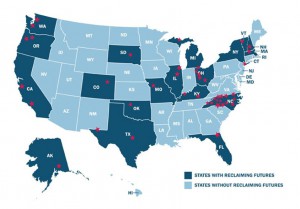Girls and Opioids: Vulnerabilities & Opportunities
By Reclaiming Futures, September 06 2017
In two separate blog posts in 2016, we discussed opioid use rates and substance use issues among adolescent girls involved with juvenile justice. In July 2017, the United States Department of Health and Human Services, Office on Women’s Health (OWH) released a report on opioid use, misuse, and overdose in women. The report provides information on the gender-specific issues and gaps in knowledge regarding females with substance use concerns/disorders. The report discusses the differences among females and males regarding the progression of substance use, the biological, social, and cultural issues (e.g., pain; relationships; family/parenting; trauma, determinants of health), effective treatments and barriers to implementation, and areas for further research. As it relates to adolescent girls (ages 12-17 years old), the report indicates they are more likely to use and become dependent on non-medical uses of prescription drugs as compared to adolescent boys. Access to prescription drugs can come from a home medicine cabinet and may help relieve mental health or physical pain symptoms and/or be part of their peer culture.Read more...




 Every week Reclaiming Futures rounds up the latest news on juvenile justice reform, adolescent substance use treatment, and teen mental health.
Every week Reclaiming Futures rounds up the latest news on juvenile justice reform, adolescent substance use treatment, and teen mental health. 



 A report from the
A report from the 
 After years of research, Vera’s Family Justice Program has implemented new programs which will contribute to easier access for family members seeking out their incarcerated loved ones. Considering youth school performance and behavior are both directly affected by family visitation, the
After years of research, Vera’s Family Justice Program has implemented new programs which will contribute to easier access for family members seeking out their incarcerated loved ones. Considering youth school performance and behavior are both directly affected by family visitation, the  The juvenile justice system, in a sense, functions to replace a core family function: discipline of a child. While this is an important governmental role in some cases, it is necessary to ensure that families are not unnecessarily displaced, and in fact included in juvenile justice to the highest degree possible.
The juvenile justice system, in a sense, functions to replace a core family function: discipline of a child. While this is an important governmental role in some cases, it is necessary to ensure that families are not unnecessarily displaced, and in fact included in juvenile justice to the highest degree possible. A new white paper from
A new white paper from  In 2001, my 13 year old son, Corey, was sent to what the New York Times called, “the worst juvenile prison in the country.” What crime had he committed that earned him this hellish journey? He stole a $300 stereo out of a pick-up after he smashed out the window with a crowbar. His sentence was 5 years in the one of the most brutal facilities in the U.S.
In 2001, my 13 year old son, Corey, was sent to what the New York Times called, “the worst juvenile prison in the country.” What crime had he committed that earned him this hellish journey? He stole a $300 stereo out of a pick-up after he smashed out the window with a crowbar. His sentence was 5 years in the one of the most brutal facilities in the U.S. I am currently in the process of preparing this year’s syllabus for the companion course that I teach with the
I am currently in the process of preparing this year’s syllabus for the companion course that I teach with the  My oldest friend emailed this past week with a blow to the heart: Joann McArthur had died, of cancer, on her 70th birthday.
My oldest friend emailed this past week with a blow to the heart: Joann McArthur had died, of cancer, on her 70th birthday. Reclaiming Futures Judge Bettina Borders
Reclaiming Futures Judge Bettina Borders Eunique is a vibrant 18-year-old African-American student at Oakland’s Fremont High whose Dad was incarcerated when she was seven years old.
Eunique is a vibrant 18-year-old African-American student at Oakland’s Fremont High whose Dad was incarcerated when she was seven years old. At 3 pm ET, Mitch Winehouse (father of late singer Amy Winehouse) is participating in a live Facebook Q&A chat on substance abuse and how it affected Amy's life. Hosted by the Partnership at Drugfree.org, Mitch will answer questions and discuss his new book, Amy, My Daughter, the inside story of
At 3 pm ET, Mitch Winehouse (father of late singer Amy Winehouse) is participating in a live Facebook Q&A chat on substance abuse and how it affected Amy's life. Hosted by the Partnership at Drugfree.org, Mitch will answer questions and discuss his new book, Amy, My Daughter, the inside story of  Over in The Atlantic Cities, Richard R. Buery Jr. of the
Over in The Atlantic Cities, Richard R. Buery Jr. of the